Parkinson Voice Project Seeking $20M to Expand SPEAK OUT! in US
Goal is to open centers, provide free speech therapy in each state

To ensure every person with Parkinson’s disease in the U.S. has access to its SPEAK OUT! speech therapy program, the Parkinson Voice Project (PVP) is seeking to raise $20 million in funding.
The goal is to establish a PVP Therapy & Research Center in each U.S. state.
“As loved ones gather during the holiday season, we want them to know there is hope for people with Parkinson’s to preserve their speaking abilities, stay connected to family and friends, and minimize life-threatening swallowing complications,” Samantha Elandary, PVP’s founder and CEO, said in a press release sent to Parkinson’s News Today.
“Their voices don’t have to disappear,” she added.
In an interesting twist, Elandary credits the COVID-19 pandemic — which initially stopped short Parkinson’s speech therapy in the U.S. — with sparking the online sessions key to this new expansion of the Parkinson Voice Project.
Parkinson Voice Project targeting all 50 states
Parkinson’s is thought to affect more than 1 million U.S. residents. Some 90% of patients are likely to develop problems with speech and swallowing as symptoms of the neurodegenerative disease.
Without treatment, the patient’s voice could further weaken and the disease can lead to life-threatening swallowing complications.
To that end, the Parkinson Voice Project established its SPEAK OUT! program in 2010 to help patients speak “with intent.” The program combines individual speech therapy, speech and singing groups, daily home practice, educational tools, and regular re-assessments of patients’ progress.
According to PVP, Parkinson’s patients who have consistently followed the SPEAK OUT! protocol have maintained benefits for more than a decade.
The idea for the online approach and widespread research centers was borne of the COVID-19 pandemic. Early on, the PVP cancelled in-person individual and group sessions and began providing online speech practice sessions to help patients retain their voices while isolated in their homes.
“We know if people with Parkinson’s miss practice or therapy, they will regress and run the risk of losing their speaking abilities,” Elandary said. “Even missing three days of vocal exercise could make a big difference.”
During the first week of online practice, there were 30 participants. These days, more than 2,500 patients globally practice with PVP daily.
“The solution to preserving speech and swallowing,” Elandary said, “involves consistent vocal exercise and hard work.”
In May 2020, the PVP clinic pivoted to a “telepractice” and began offering online therapy sessions in earnest.
“As we and the patients became more tech-savvy, we realized we had crossed over to a more beneficial therapy approach for the Parkinson’s population,” Elandary said.
Online therapy obviates transportation issues and allows for more family involvement. Further, it allows access to homebound patients and those living in rural communities.
Because each state has its own regulations for speech pathology licensure, the Parkinson Voice Project may only treat patients in Texas, where PVP is based. That meant that, to achieve its goals, the PVP had to craft a way to help patients who don’t live in the state.
That led to the “Campaign to Reach America” effort, which is expanding the nonprofit’s programs.
Through the campaign, the organization has already raised more than half its $20 million goal. The aim is to establish the first 10 PVP centers next year outside Texas.
The new centers will provide free online speech therapy to people with the progressive neurodegenerative disorder throughout the nation.
“Once we can replicate our free online program in just one clinic in every state, that clinic can treat any person with Parkinson’s living in that state. Every person with Parkinson’s in America will have access to SPEAK OUT!,” Elandary said.
The organization’s ultimate aim is to make SPEAK OUT! available to patients globally. Parkinson’s Voice Project has trained more than 11,000 speech-language pathologists and graduate students in its approach.







